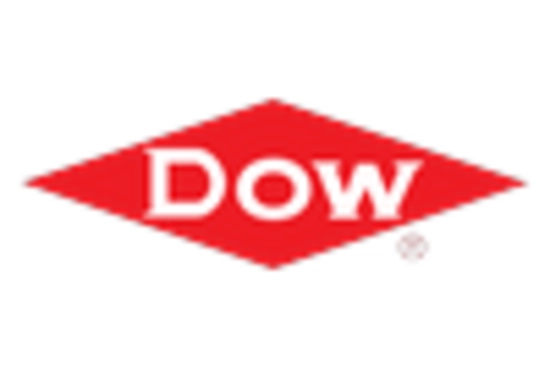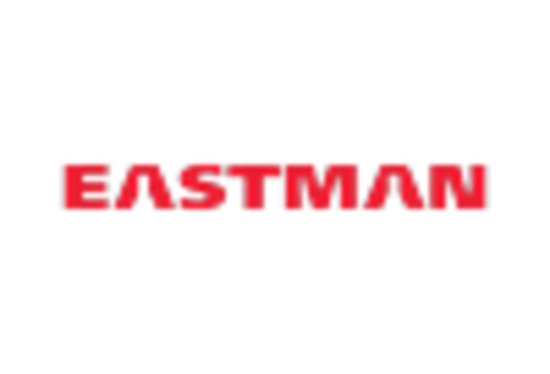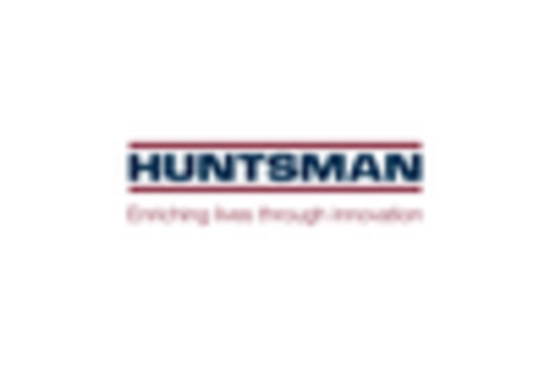Rising Demand for Surfactants
The Ethylene Oxide Derivatives Market experiences a notable increase in demand for surfactants, which are essential in various applications such as detergents, personal care products, and industrial cleaners. This demand is driven by the growing consumer preference for eco-friendly and biodegradable products. In 2025, the market for surfactants derived from ethylene oxide is projected to reach approximately USD 25 billion, reflecting a compound annual growth rate of around 5%. The shift towards sustainable formulations is likely to further bolster the market, as manufacturers seek to innovate and meet consumer expectations for environmentally responsible products. Consequently, the rising demand for surfactants is a pivotal driver for the Ethylene Oxide Derivatives Market.
Expansion in End-Use Industries
The Ethylene Oxide Derivatives Market is significantly influenced by the expansion of end-use industries such as automotive, textiles, and pharmaceuticals. These sectors increasingly utilize ethylene oxide derivatives for applications ranging from antifreeze agents to textile processing and pharmaceutical formulations. For instance, the automotive industry is projected to grow at a rate of 4% annually, leading to heightened demand for ethylene oxide-based products. This expansion is indicative of a broader trend where diverse industries are recognizing the versatility and efficacy of ethylene oxide derivatives, thereby driving market growth. As these industries continue to evolve, the Ethylene Oxide Derivatives Market is poised to benefit from their increasing reliance on these chemical derivatives.
Increasing Regulatory Standards
The Ethylene Oxide Derivatives Market is subject to increasing regulatory standards aimed at ensuring safety and environmental protection. Governments and regulatory bodies are implementing stricter guidelines regarding the use of chemicals, particularly those derived from ethylene oxide. This trend is evident in the formulation of new regulations that mandate the reduction of hazardous substances in consumer products. Compliance with these regulations often necessitates the development of safer and more sustainable alternatives, which can drive innovation within the industry. As manufacturers adapt to these evolving standards, the Ethylene Oxide Derivatives Market may witness a shift towards more compliant and environmentally friendly products, thereby influencing market dynamics.
Innovations in Chemical Processes
Innovations in chemical processes are transforming the Ethylene Oxide Derivatives Market, enhancing production efficiency and product quality. Advances in catalysis and process optimization are enabling manufacturers to produce ethylene oxide derivatives with reduced energy consumption and lower environmental impact. For example, the introduction of more efficient catalytic processes has the potential to decrease production costs by up to 15%, making these derivatives more competitive in various applications. Furthermore, these innovations align with the industry's shift towards sustainability, as they often result in lower emissions and waste generation. As a result, the ongoing technological advancements are likely to serve as a crucial driver for the Ethylene Oxide Derivatives Market.
Growth in Agricultural Applications
The Ethylene Oxide Derivatives Market is experiencing growth due to the increasing use of ethylene oxide derivatives in agricultural applications. These derivatives are utilized in the formulation of agrochemicals, including pesticides and herbicides, which are essential for enhancing crop yield and protecting against pests. The agricultural sector is projected to grow at a rate of 3% annually, driven by the need for improved food security and sustainable farming practices. As farmers seek effective solutions to combat agricultural challenges, the demand for ethylene oxide-based agrochemicals is likely to rise. This trend underscores the importance of agricultural applications as a key driver for the Ethylene Oxide Derivatives Market.

















Leave a Comment